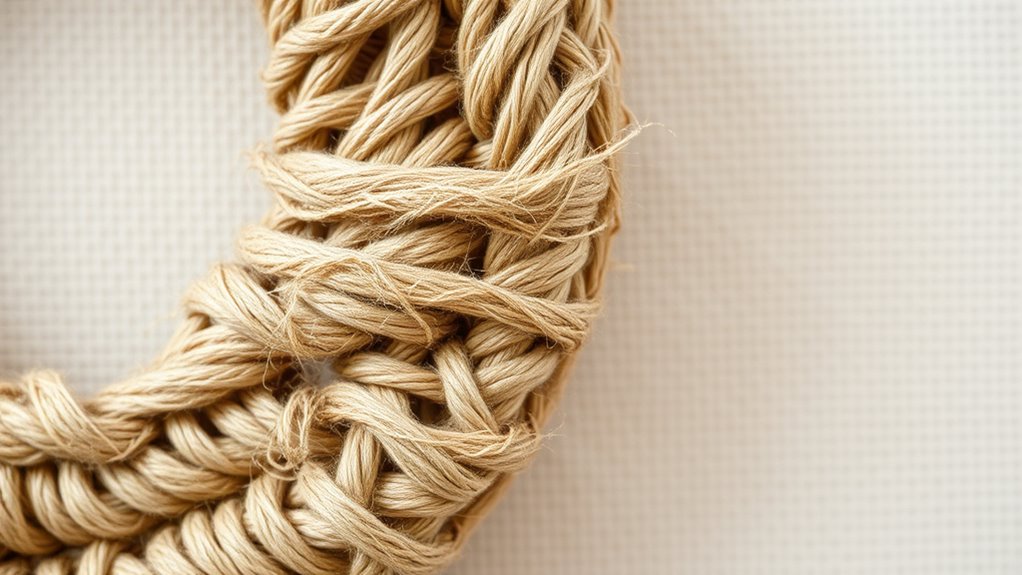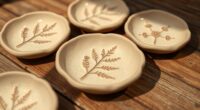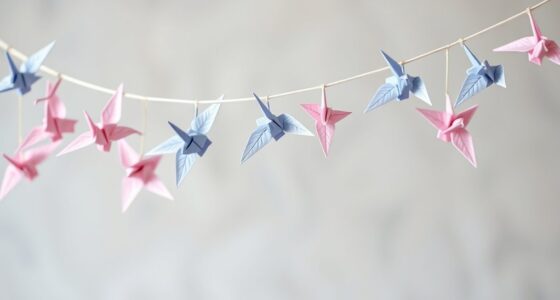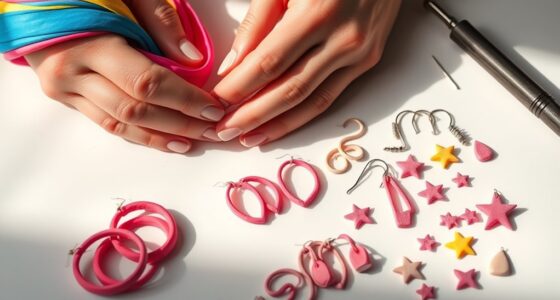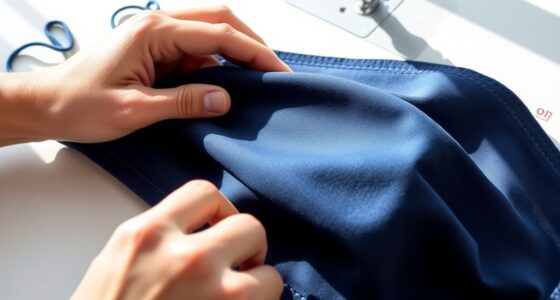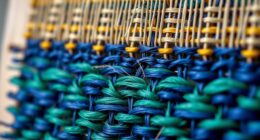Fiber-wrapped hoop wall art lets you customize your space with vibrant colors and textured patterns using natural fibers like jute or cotton. Choose a sturdy hoop that fits your style and guarantee it’s clean and sanded for better fibers’ grip. Wrap the fibers tightly, secure with glue or stitches, and add embellishments such as beads or charms for a personal touch. Want tips on design ideas, display, or maintenance? Keep exploring to create stunning, sustainable art.
Key Takeaways
- Select durable hoops made of metal, wood, or plastic and prepare them with cleaning and light sanding for secure fiber wrapping.
- Choose eco-friendly fibers like jute, hemp, or cotton to enhance texture, sustainability, and visual interest.
- Wrap fibers tightly around the hoop, securing ends with glue or stitches, and incorporate varied colors and textures for depth.
- Add embellishments such as beads, feathers, or charms to personalize and create focal points in the artwork.
- Hang with adjustable hooks, use proper lighting, and clean regularly to maintain the wall art’s appearance and longevity.
Materials Needed for Fiber-Wrapped Hoop Art
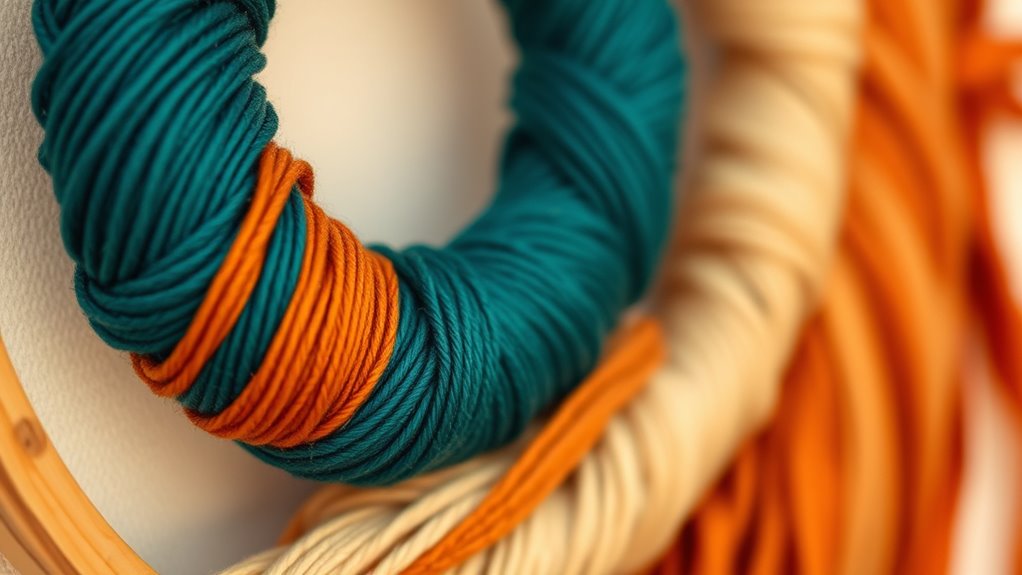
To create stunning fiber-wrapped hoop wall art, you’ll need a few essential materials. First, select your fiber based on color, texture, and thickness—options include yarn, raffia, or fabric strips. Next, choose a sturdy hoop, such as metal or wooden, and prepare it by cleaning and lightly sanding if necessary to guarantee the fiber adheres well. Gather scissors for cutting your fiber, as well as a hot glue gun or craft glue for securing ends and securing the fiber to the hoop. You might also want additional decorative elements like beads or feathers, but focus on fiber selection and hoop preparation to establish a solid foundation for your project. Having these materials ready will make your crafting process smooth and enjoyable.
Choosing the Right Hoop Size and Material
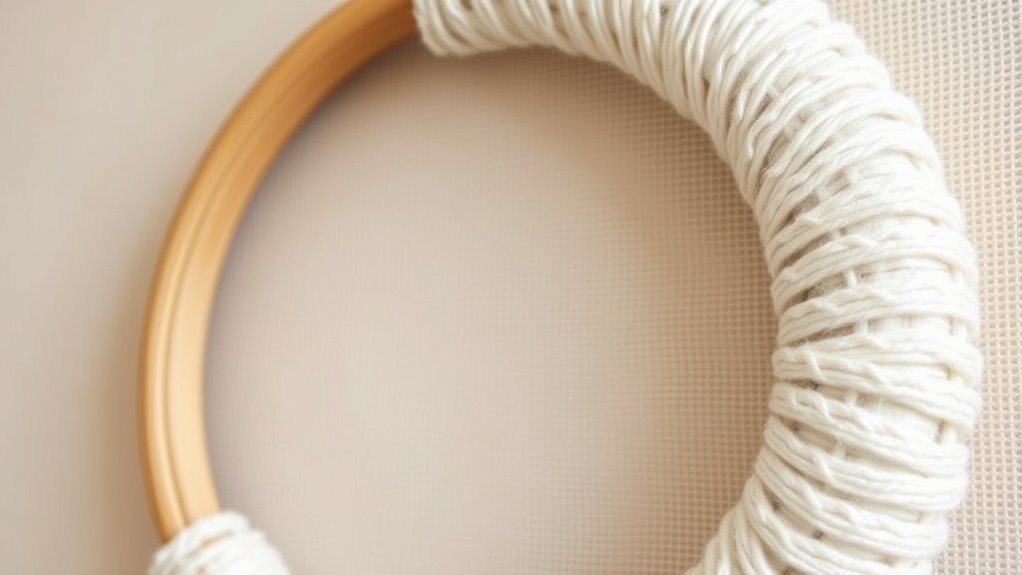
Choosing the right hoop size and material sets the foundation for your fiber-wrapped wall art. When considering hoop size, think about the space where you’ll hang your piece and the visual impact you want. Larger hoops create bold statements, while smaller ones suit more subtle designs. Hoop size considerations also influence how much fiber you’ll need. For choosing hoop material, options like wooden, metal, or plastic each offer different textures and durability. Wooden hoops provide a natural look, metal hoops are sturdy and sleek, and plastic hoops are lightweight and affordable. Your choice should reflect your style and the overall aesthetic you aim for. Selecting the right combination of hoop size and material ensures your project is both visually appealing and structurally sound.
Selecting Natural Fibers for Your Project
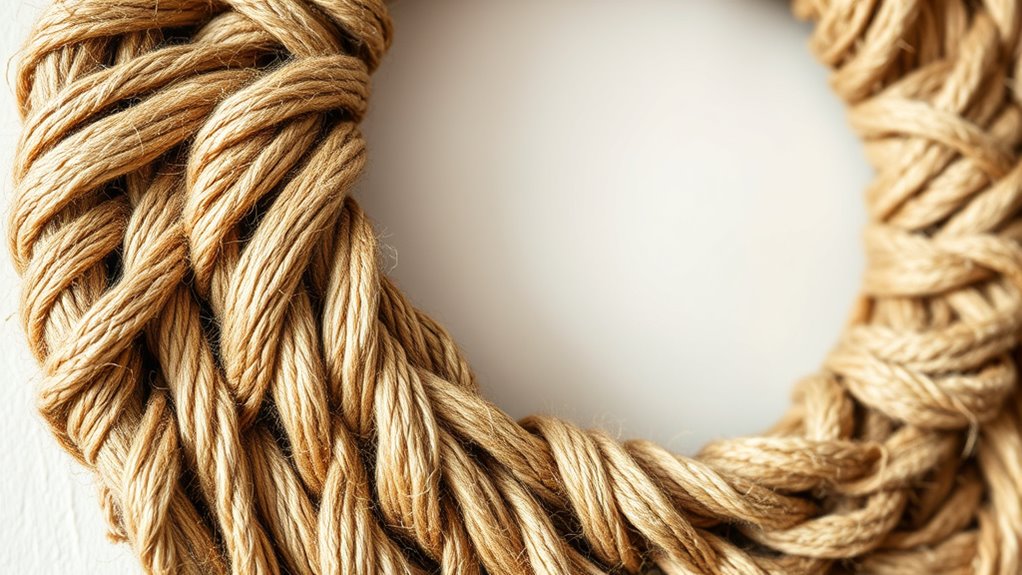
Selecting natural fibers for your project can markedly enhance the texture and authenticity of your fiber-wrapped hoop wall art. When choosing fibers, consider their durability, appearance, and how well they take fiber dyeing to achieve vibrant colors. Prioritize sustainable sourcing to guarantee your materials are eco-friendly and ethically harvested. Here are some top options: 1. Jute – Strong, rustic, and eco-friendly, perfect for a natural look. 2. Hemp – Durable with a smooth finish, ideal for fiber dyeing. 3. Cotton – Soft, versatile, and widely available, great for detailed wrapping. Incorporating fiber exfoliation techniques can also add unique textures to your artwork, and selecting safe, durable materials ensures longevity and safety of your finished piece. Additionally, choosing fibers with sustainable sourcing can support environmentally responsible practices in your creative process.
Techniques for Wrapping and Securing Fibers
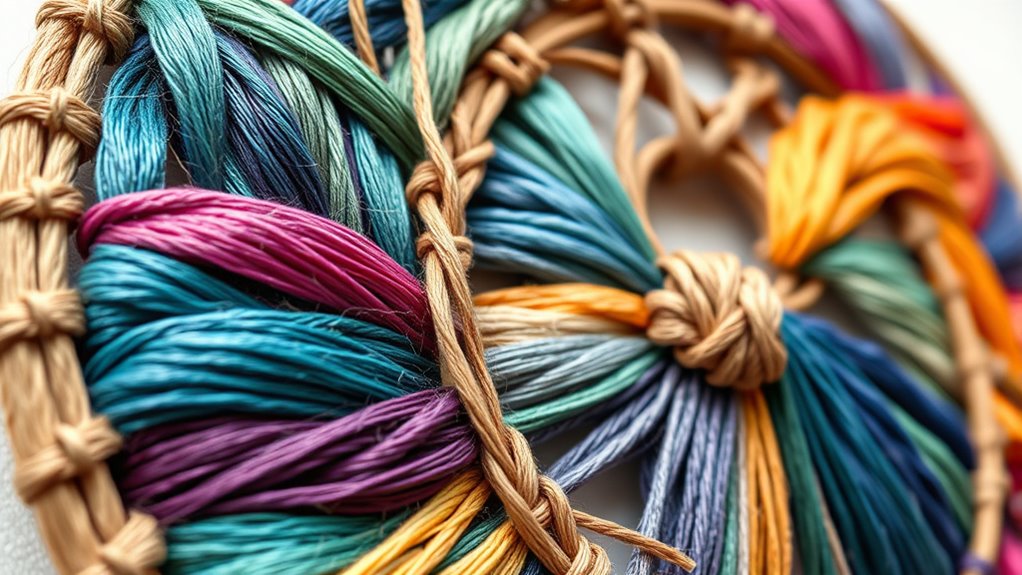
Mastering the techniques for wrapping and securing fibers is essential to creating a polished and durable hoop wall art piece. Start by choosing your fibers and applying fiber dyeing techniques to add vibrant colors and unique patterns that reflect your style. When wrapping, keep tension consistent to ensure an even, professional look. Use hot glue, fabric glue, or a needle and thread to secure fibers at the start, end, and any twists or turns. For hoop personalization, consider wrapping multiple fibers in different colors or textures, securing each layer tightly. Be patient and methodical, checking the tension and alignment as you go. Properly secured fibers prevent unraveling, giving your artwork a clean finish and lasting durability. Additionally, selecting high-quality fibers and securing them with appropriate adhesives or stitches ensures long-lasting results. Incorporating secure attachment techniques can help maintain the integrity of your piece over time. Recognizing the importance of fiber quality can also significantly influence the overall appearance and longevity of your wall art. Paying attention to industry trends can inspire new design ideas and techniques to elevate your work.
Adding Embellishments and Textural Details
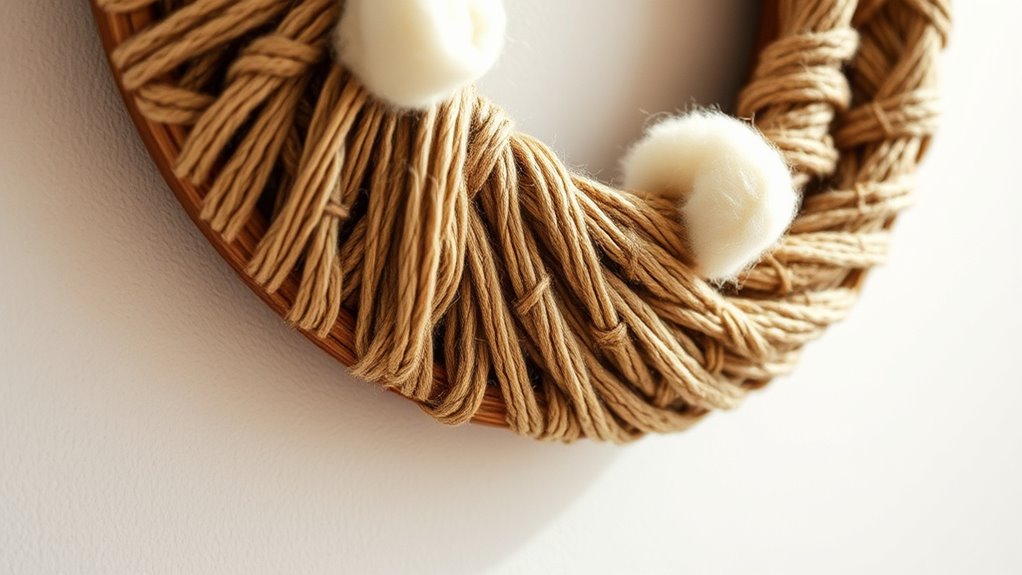
Adding embellishments and textural details can really make your hoop wall art stand out. You can incorporate metallic accents for a touch of shine, layer different textures for depth, or add decorative elements like beads and charms. These details allow you to personalize your piece and create a visually interesting focal point. Incorporating various materials can further enhance the tactile appeal of your artwork. Exploring different textural techniques can also add more dimension and interest to your creation. Understanding how sound techniques influence emotional perception can inspire unique creative choices in your design process. Recognizing the emotional effects of different textures can help convey specific moods or atmospheres in your artwork, especially when considering how tactile stimulation impacts mental clarity and health.
Incorporate Metallic Accents
Metallic accents can instantly elevate your fiber-wrapped hoop wall art by adding a touch of shine and sophistication. You can achieve this with simple techniques like using metallic paint or applying foil accents. These details catch the light beautifully and create visual interest. Here are three ways to incorporate metallic accents:
- Use metallic paint to add subtle highlights or bold streaks on your fiber wrapping.
- Apply foil accents in geometric shapes or abstract patterns for a modern look.
- Combine metallic paint with foil accents for layered, textured effects that stand out.
Use Layered Textures
To enhance your fiber-wrapped hoop wall art, layering textures with various embellishments and details can create a dynamic, eye-catching piece. Start by experimenting with fiber dyeing techniques to add depth and color variation, giving your design a rich foundation. Incorporate different materials like fabric strips, yarns, or textured fibers to build tactile interest. Hoop customization allows you to tailor the structure to support these layered textures, ensuring stability and visual balance. As you add these details, think about contrast in thickness and surface, which will make your art more engaging. Layering textures not only adds dimension but also highlights your craftsmanship, making each piece uniquely yours. This approach transforms a simple hoop into a captivating, multi-dimensional work of art.
Add Decorative Elements
Enhancing your fiber-wrapped hoop wall art with decorative elements brings your piece to life and adds a personalized touch. Incorporating embellishments creates unique wall accents that elevate your interior decor. Here are some ideas to contemplate:
- Add beads or sequins – These small details catch the light and add shimmer, making your wall art more eye-catching.
- Attach dried flowers or leaves – Natural elements introduce texture and a touch of nature’s beauty.
- Incorporate fabric or ribbon accents – These materials add layers and visual interest, making your wall decor stand out.
Creative Design Ideas and Pattern Inspirations
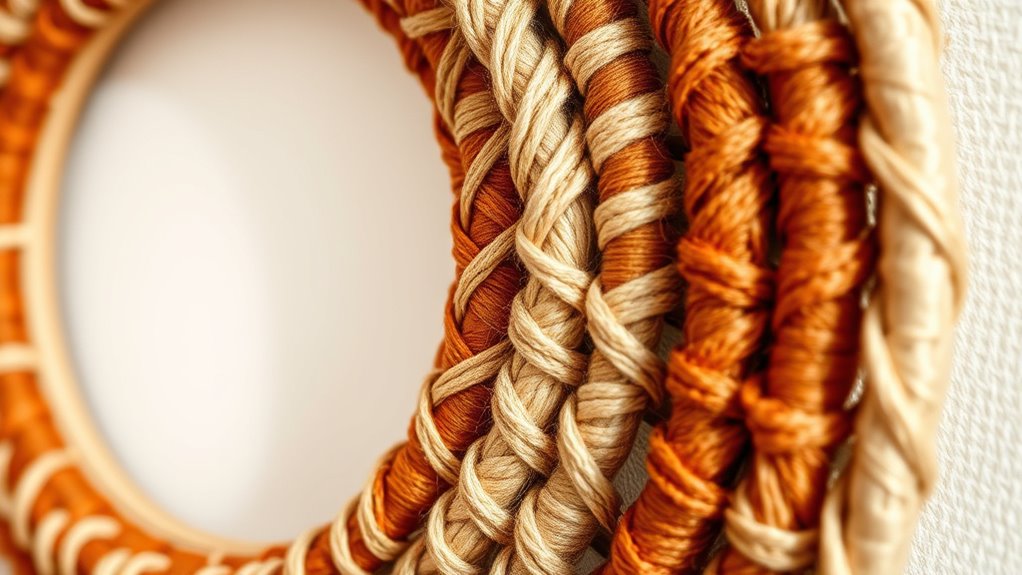
Explore how mixing vibrant colors and varied textures can make your hoop wall art stand out. Experiment with different geometric patterns to create visual interest and depth. These ideas can inspire unique designs that reflect your personal style and creativity. Incorporating active listening techniques can also enhance your understanding of how different patterns and textures interact visually. Additionally, understanding global economic outlooks can inspire you to select color palettes and textures that resonate with current design trends influenced by international markets. Embracing creative practice can help you develop new techniques for combining colors and textures, making your artwork more dynamic and engaging. Incorporating diverse materials such as recycled or unconventional elements can further elevate your creative expression. Developing an awareness of well-being tips can also assist in creating a balanced and satisfying artistic process that promotes personal fulfillment.
Color and Texture Mix
Have you considered how combining bold colors with varied textures can make your fiber-wrapped hoop wall art truly stand out? Using fiber dyeing techniques allows you to achieve vibrant hues while supporting textile sustainability. Mixing textures adds depth and tactile interest, making your piece more engaging. Here are some creative ideas:
- Use eco-friendly dyes to create gradient effects with fiber dyeing, enhancing color richness.
- Incorporate natural fibers like jute or hemp for textured contrast and sustainability.
- Pair matte and shiny finishes to add visual dynamism without overpowering the color palette.
Experiment with these combinations to craft a striking, eco-conscious artwork that captures attention and reflects your style and values.
Geometric Pattern Variations
Incorporating geometric patterns into your fiber-wrapped hoop wall art opens up a world of creative possibilities. You can experiment with various shapes like triangles, squares, or hexagons to create striking visual effects. Fiber dyeing allows you to customize colors within these patterns, adding depth and vibrancy. Using different fiber types and dye techniques can produce intricate, layered designs that enhance the geometric look. Additionally, embracing hoop sustainability by repurposing old hoops or choosing eco-friendly materials makes your art more environmentally conscious. Combining fiber dyeing with geometric pattern variations encourages you to blend colors and shapes thoughtfully, resulting in unique, modern wall art. This approach not only elevates your crafting skills but also supports sustainable practices in your creative process.
Tips for Hanging and Displaying Your Artwork
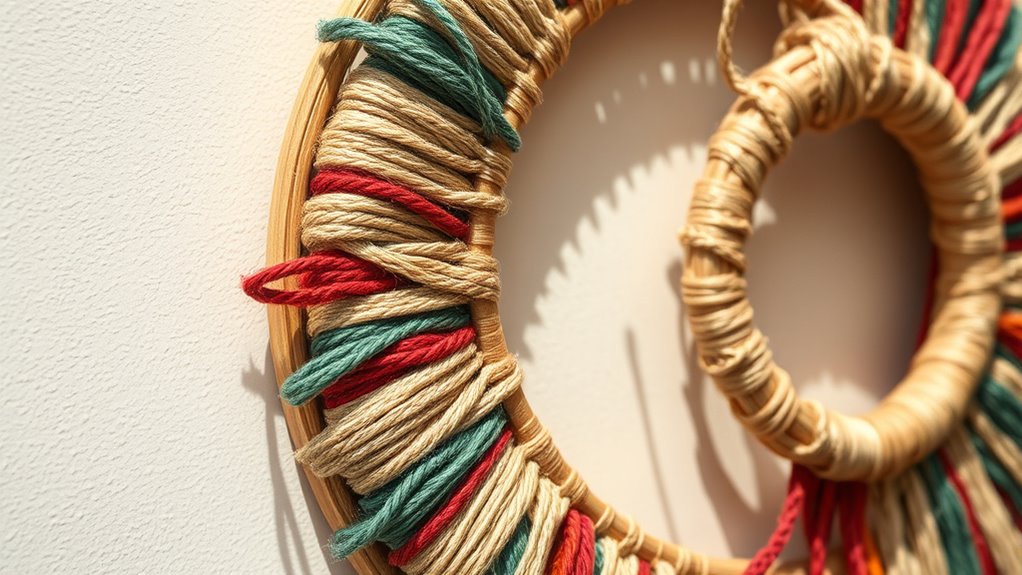
Hanging and displaying your fiber-wrapped hoop wall art effectively can transform your space. To maximize impact, consider lighting tips—use soft, directional lighting to highlight textures and colors. Experiment with different angles to create shadows that add depth. When it comes to framing options, choose hooks or gallery rails that support the weight without damaging your wall. Keep these tips in mind:
Enhance your fiber hoop art with strategic lighting and secure framing for a stunning display.
- Use adjustable hooks for precise placement and easy adjustments.
- Incorporate accent lighting, like picture lights or wall sconces.
- Select framing options that complement your artwork’s style, such as minimalist or decorative frames.
- Incorporate wall decor trends to keep your display contemporary and stylish, and be mindful of visual balance to ensure your art remains the focal point. Considering the artistic style of your wall decor can also enhance the overall aesthetic. Additionally, be aware of beauty store hours to plan your shopping trips effectively when selecting materials and accessories.
Maintaining and Caring for Your Fiber Art Pieces
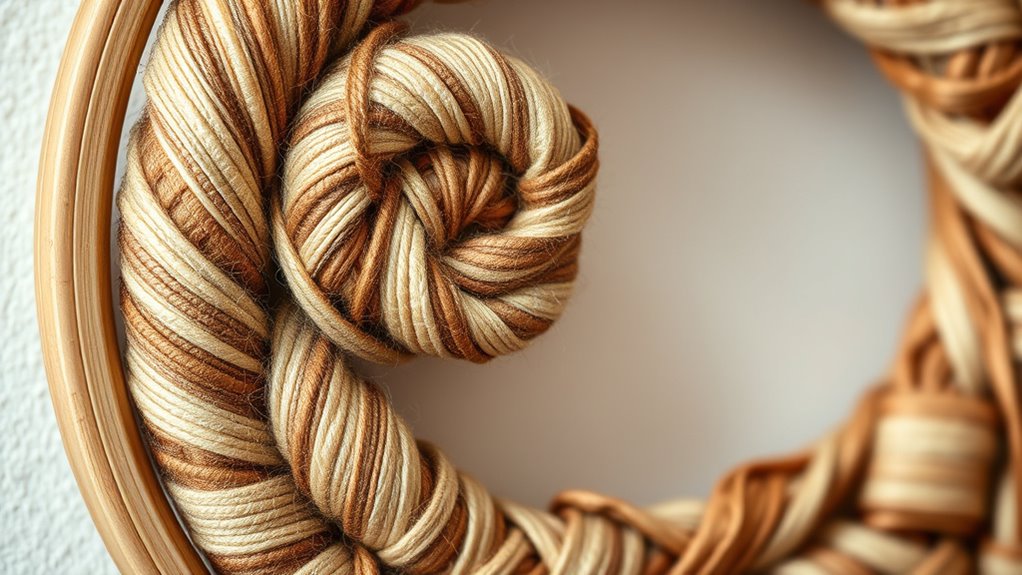
To keep your fiber art pieces looking their best, regular maintenance is essential. Proper fiber preservation involves gentle cleaning techniques to prevent dust and dirt buildup. Use a soft brush or a low-suction vacuum with a brush attachment to carefully remove surface debris without damaging the fibers. Avoid harsh chemicals or water, as they can weaken or discolor the materials. If your piece needs more thorough cleaning, lightly spot clean with a damp cloth and let it air dry completely. Keep your fiber art away from direct sunlight and humid environments, which can cause fading and fiber deterioration. Regularly inspecting your artwork helps you catch any issues early, ensuring lasting beauty and integrity. Proper care keeps your fiber‑wrapped hoop wall art vibrant and preserved for years to come.
Frequently Asked Questions
How Long Does It Take to Complete a Fiber-Wrapped Hoop Wall Art?
The time estimation for completing this project depends on your skill level and the complexity you choose. If you’re a beginner, it might take several hours or even a weekend to finish. More experienced crafters can complete it in a shorter time, perhaps a few hours. You should plan accordingly, allowing extra time for troubleshooting or perfecting details. Your pace and project intricacy directly influence how long it takes to finish.
Can I Customize the Color Schemes Easily?
Like an artist with a blank canvas, you can easily customize your color scheme. The process of fabric dyeing allows you to create unique shades that match your style perfectly. With simple color customization techniques, you can choose vibrant or subtle tones, making your wall art truly one-of-a-kind. Whether you prefer bold contrasts or harmonious hues, fabric dyeing gives you the freedom to personalize your piece effortlessly.
Is This Project Suitable for Children or Beginners?
This project is great for children and beginners because it’s simple and child-friendly. You can easily find beginner crafting tips online to guide you through the process. It’s a fun way to introduce kids to crafting activities that develop their creativity and fine motor skills. Plus, the steps are straightforward, making it a perfect choice for those new to DIY projects, ensuring everyone can enjoy making something beautiful together.
What Safety Precautions Should I Consider During Crafting?
When crafting, you should always prioritize safety. Wear appropriate safety gear, like gloves and goggles, to protect your hands and eyes from sharp tools and materials. Make certain your workspace has good ventilation to avoid inhaling fumes or dust. Keep your area organized, and handle tools carefully to prevent accidents. Taking these precautions helps you enjoy your project safely and reduces the risk of injuries.
Are There Eco-Friendly or Sustainable Fiber Options Available?
You wonder if eco-friendly fiber options exist. Yes, you can choose recycled fibers, which repurpose materials and reduce waste, making your craft more sustainable. Biodegradable materials are also available, breaking down naturally without harming the environment. By selecting these options, you contribute to eco-conscious crafting and create beautiful, sustainable art. Always check product labels or ask suppliers about their eco-friendly fibers to guarantee you’re making the best choice.
Conclusion
Like a timeless tapestry, your fiber-wrapped hoop wall art reflects your unique story and creativity. As you craft each piece, remember that beauty often lies in the details and patience you invest. Your artwork becomes a silent yet powerful expression—a reminder that, like art itself, life’s richness comes from the delicate balance of effort and inspiration. Keep creating, and let your walls tell your story with every fiber you weave.
